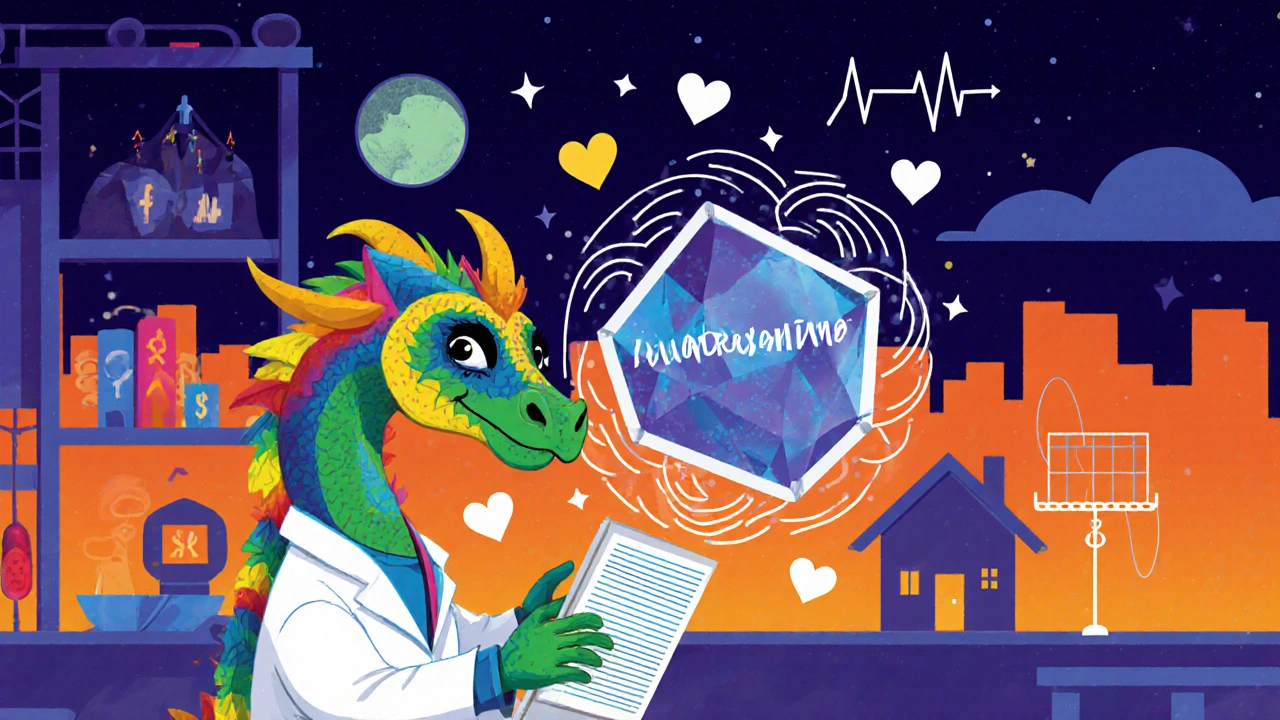Heart Rate Threshold Calculator
Resting Heart Rate Assessment
Ivabradine is indicated for patients with heart failure or chronic stable angina whose resting heart rate remains above 70 bpm despite standard therapy.
Important Considerations
Bradycardia Risk: Ivabradine can cause heart rates below 50 bpm. Monitor heart rate 2 hours after dose and adjust if necessary.
Visual Effects: Transient visual phosphenes may occur initially but typically resolve after a few weeks.
Drug Interactions: Avoid strong CYP3A4 inhibitors like ketoconazole as they increase ivabradine levels.
Imagine a heart that can’t speed up when you run, climb stairs, or feel stressed. That’s the problem many patients with cardiac conditions face: an uncontrolled heart rate that worsens their disease. Ivabradine steps in as a drug that specifically slows the heart without dropping blood pressure, offering a new option where older medicines fall short.
What Is Ivabradine?
Ivabradine is a selective inhibitor of the funny (If) current in the sino‑atrial node, used to reduce heart rate in patients with certain cardiovascular conditions. First approved in Europe in 2005 and later by the FDA in 2015, it targets the pacemaker cells of the heart directly, unlike beta‑blockers that act on the entire sympathetic nervous system.
Why Target Heart Rate?
High resting heart rate is an independent risk factor for heart failure, myocardial infarction, and premature death. By lowering beats per minute (bpm) to a safer range (typically 50‑60bpm), the heart uses less oxygen, improves filling time, and reduces strain on the ventricular walls.
Mechanism of Action - The “Funny” Current
The sino‑atrial node generates spontaneous electrical activity. A specific ion channel, the hyperpolarization‑activated cyclic nucleotide‑gated (HCN) channel, carries the so‑called "funny" (If) current. Ivabradine binds to these channels, prolonging their opening time and thus slowing the depolarisation rate. The result: fewer impulses per minute, a slower heart rate, and preserved contractility.
Key Clinical Indications
- Chronic stable angina - especially when patients cannot tolerate beta‑blockers.
- Heart failure with reduced ejection fraction (HFrEF) - added to standard therapy when heart rate remains >70bpm.
- Off‑label uses such as inappropriate sinus tachycardia and certain post‑operative arrhythmias.

How Ivabradine Stacks Up Against Traditional Therapies
| Feature | Ivabradine | Beta‑Blockers | Calcium Channel Blockers |
|---|---|---|---|
| Primary target | If‑channel in SA node | β‑adrenergic receptors | L‑type calcium channels |
| Effect on blood pressure | Neutral | Usually lowers | May lower |
| Impact on contractility | None | Negative inotropic | Variable |
| Indicated for heart failure | Yes (added to GDMT) | Yes (standard) | No |
| Common side effects | Bradycardia, visual phosphenes | Fatigue, bronchospasm | Edema, constipation |
Dosage and Administration
- Start with 5mg twice daily (morning and evening) for most adults.
- Measure resting heart rate 2hours after the dose; if < 50bpm, reduce to 2.5mg twice daily.
- Maximum approved dose is 7.5mg twice daily.
- Adjust for hepatic impairment: use the lower 2.5mg dose.
- Do not co‑prescribe strong CYP3A4 inhibitors (e.g., ketoconazole) as they raise plasma levels.
Safety Profile and Side Effects
Overall, ivabradine is well tolerated. The most frequently reported adverse events are:
- Bradycardia - usually asymptomatic, but monitor if patients have AV‑node disease.
- Visual disturbances - transient luminous phenomena (phosphenes) that disappear after a few weeks.
- Headache and dizziness - often linked to the drop in heart rate.
Rare but serious concerns include atrial fibrillation and worsening heart failure if the dose is too high. Routine ECG monitoring is recommended during the first month of therapy.

Evidence from Major Clinical Trials
The SHIFT (Systolic Heart failure treatment with the I(f) inhibitor ivabradine) trial enrolled 6,558 patients with HFrEF (NYHA class II-IV) and resting heart rate ≥70bpm. Over a median follow‑up of 22.9months, ivabradine reduced the composite endpoint of cardiovascular death or hospitalisation for worsening heart failure by 18% (hazard ratio 0.82, p=0.001). Importantly, all patients were already on optimal beta‑blocker therapy, highlighting the additive benefit.
In chronic stable angina, the ADD‑A (A Study of the Efficacy of Ivabradine vs. Placebo) trial showed a 30% reduction in weekly angina episodes compared with placebo, with similar exercise tolerance improvements as beta‑blockers but without blood pressure changes.
Practical Tips for Clinicians
- Patient selection: Ideal candidates have a resting HR >70bpm despite maximally tolerated beta‑blockers, or cannot tolerate beta‑blockade at all.
- Monitoring: Check heart rate 2hours post‑dose, repeat ECG at 1‑month, and watch for visual phosphenes.
- Drug interactions: Avoid concomitant strong CYP3A4 inhibitors; dose‑adjust with amiodarone.
- Education: Tell patients that seeing brief flashes of light is normal and usually resolves.
- Withdrawal: If stopping therapy, taper over a few days to avoid rebound tachycardia.
Future Directions
Research is expanding ivabradine beyond heart failure and angina. Ongoing studies explore its role in post‑myocardial infarction remodeling, atrial fibrillation rate control, and even pulmonary hypertension where heart rate reduction may improve right‑ventricular function. Early-phase data suggest synergistic effects when combined with newer SGLT2 inhibitors, hinting at a multi‑drug strategy for high‑risk cardiac patients.
Frequently Asked Questions
What is the main advantage of ivabradine over beta‑blockers?
Ivabradine lowers heart rate without affecting blood pressure or causing bronchospasm, making it suitable for patients who can’t tolerate beta‑blockers.
Can ivabradine be used in patients with atrial fibrillation?
No. Ivabradine requires a functioning sinus node; it is ineffective and potentially harmful in atrial fibrillation.
How quickly does ivabradine start working?
Heart rate reduction can be seen within 2‑4hours after the first dose, with maximal effect after 2‑3days of consistent dosing.
What are the most common side effects?
Bradycardia, transient visual phosphenes, and mild headaches. Serious events are rare but require prompt medical review.
Is ivabradine safe for elderly patients?
Yes, provided dose is adjusted and heart rate is monitored closely. The drug’s neutral blood‑pressure profile is advantageous in older adults with co‑existing hypertension.
Can ivabradine be taken with other heart‑failure drugs?
It is designed to be added to guideline‑directed medical therapy, including ACE inhibitors, ARBs, mineralocorticoid receptor antagonists, and SGLT2 inhibitors.
What monitoring is required after starting therapy?
Check resting heart rate 2hours post‑dose, repeat ECG at 1‑month, and assess for symptoms of bradycardia or visual disturbances.
Is ivabradine approved for use in the UK?
Yes. The Medicines and Healthcare products Regulatory Agency (MHRA) authorized ivabradine for chronic stable angina and HFrEF in 2016.
How does ivabradine compare cost‑wise to other heart‑rate‑lowering drugs?
Generic versions are now available in the EU, bringing the monthly cost close to that of generic beta‑blockers, though brand‑name pricing can be higher in some markets.

CHIRAG AGARWAL
October 17, 2025 AT 14:57Ivabradine sounds like a decent backup for beta‑blocker intolerants.
genevieve gaudet
October 19, 2025 AT 22:30Reading through the mechanisms makes me think about how we constantly chase the newest drug like it’s a cultural trend, yet the heart’s rhythm is something ancient. The funny current is a quirky name, but it literally means “weird” in Latin, which fits the whole concept. It’s fascinating that we can dial down a heartbeat without touching blood pressure, almost like a meditation practice in pill form. I guess modern cardiology is blending science with a bit of art, and Ivabradine sits right in the middle.
Carissa Padilha
October 22, 2025 AT 06:03What catches my eye is the neutrality on blood pressure – that’s a huge plus for patients who are already on multiple antihypertensives. The side‑effect profile seems manageable; most folks just notice a fleeting flash of light, which isn’t life‑threatening. Still, the cost can be an issue in places without generic versions, so accessibility remains a hidden hurdle. Clinical trials like SHIFT show a solid reduction in hospitalisations, but real‑world adherence sometimes tells a different story. I also wonder how many clinicians actually feel comfortable titrating a drug that you can’t measure with a simple cuff. All in all, it’s a promising tool, but like any medicine, the devil’s in the details.
Richard O'Callaghan
October 23, 2025 AT 23:43Yo, you kinda over‑romanticize the whole thing – it’s just a drug, not some zen mantra. Also, “ancient” and “Latin” mix up, but whatever.
Joanna Mensch
October 25, 2025 AT 17:23Sure, the trials look good, but who’s really funding them? There’s always a hidden agenda lurking behind those glossy results.
RJ Samuel
October 27, 2025 AT 18:23Look, I’m not buying the hype that Ivabradine is a miracle pill. It only works if your sinus node is intact, which excludes a chunk of the sickest patients. Plus, the visual phosphenes are like a cheap light show you never asked for. If you’re already on a beta‑blocker, why add another layer of complexity?
Sara Werb
October 29, 2025 AT 20:23Hold up!!! You’re basically trashing a medication that’s helped thousands of people across the globe, and you act like you’re protecting some “pure” American heart health!!! It’s not a “layer of complexity”, it’s a lifesaver for those who can’t tolerate beta‑blockers, and you’d better remember that before spewing nonsense!!!
Steve Holmes
November 1, 2025 AT 03:57I think it’s worth highlighting the practical steps for starting Ivabradine. First, check that the resting heart rate is above 70 bpm and that the patient is on a stable dose of beta‑blocker. Then, begin with 5 mg twice daily and monitor the rate 2 hours after dosing. Adjust down if you dip below 50 bpm. Simple, right?
Tom Green
November 3, 2025 AT 11:30Exactly, and don’t forget the ECG at one month – that catches hidden conduction issues early.
Emily Rankin
November 6, 2025 AT 00:37Imagine a world where patients no longer dread the side‑effects of traditional drugs, where the heart beats calmly like a mountain lake at sunrise. Ivabradine offers that serene rhythm, a gentle whisper instead of a roaring engine. It respects the body’s own pacing, allowing the ventricles to fill fully and work efficiently. For those who have struggled with fatigue from beta‑blockers, this can be a true renaissance. In the grand tapestry of cardiology, it might just be the subtle brushstroke we needed.
Rebecca Mitchell
November 8, 2025 AT 13:43Sounds poetic but remember it’s still a pill with real side effects.
Roberta Makaravage
November 11, 2025 AT 11:10Ivabradine’s pharmacology is a textbook case of selective ion channel inhibition, targeting the HCN channel in the sino‑atrial node with remarkable specificity. By binding to the open state of the channel, it prolongs the diastolic depolarization phase, effectively reducing the slope of phase 4 and slowing the intrinsic heart rate. This mechanism is independent of adrenergic receptors, which explains why blood pressure remains largely unchanged. Consequently, patients who are hypotensive or have bronchospastic disease can tolerate the drug much better than traditional beta‑blockers. The pivotal SHIFT trial, enrolling over six thousand patients, demonstrated an 18 % relative risk reduction in the composite endpoint of cardiovascular death or heart‑failure hospitalization. Moreover, the trial’s subgroup analysis showed that the benefit persisted even in patients already on maximum beta‑blocker therapy, underscoring the additive effect of heart‑rate lowering alone. Real‑world registries have echoed these findings, reporting lower all‑cause mortality when Ivabradine is introduced early in the disease course. However, clinicians must vigilantly monitor for bradycardia; a resting rate below 50 bpm often necessitates dose reduction or temporary discontinuation. Visual disturbances, described as luminous phosphenes, occur in up to 14 % of users but are typically transient and resolve without intervention. Dose adjustments are critical in hepatic impairment, where the drug’s clearance is reduced, making the 2.5 mg twice‑daily regimen the preferred starting point. Drug interactions, particularly with strong CYP3A4 inhibitors like ketoconazole, can raise plasma concentrations dramatically, leading to excessive heart‑rate suppression. In practice, a stepwise approach-starting low, checking heart‑rate two hours post‑dose, and confirming ECG stability after one month-optimizes safety. The cost landscape has improved with the introduction of generic formulations in Europe, narrowing the price gap with generic beta‑blockers, though brand‑name pricing still varies widely across markets. Future research is exploring synergistic effects with SGLT2 inhibitors, suggesting a multi‑drug strategy could further improve outcomes in high‑risk heart‑failure populations. In summary, Ivabradine is a valuable adjunct when heart‑rate control is paramount, provided it is used judiciously and monitored closely 😊🚀
Lauren Sproule
November 14, 2025 AT 08:37Thanks for the thorough rundown – really clears things up.
Samantha Oldrid
November 17, 2025 AT 19:57Oh great, another pill to add to the list.